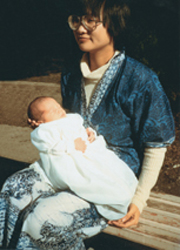|
||||||
|
||||||||||||
Questions
/ instructions:
|
||||||||||||
| %
responses |
||||||||||||
| GEd |
MI |
|||||||||||
 |
Show
photo 1. Whakaaturia
te whakaahua 1. |
|||||||||||
| 1. | Why
does Mrs Chia think it is important that Eileen learns about Chinese culture? He aha te take i whakaaro ai a Mrs Chia, e tika ana me ako a Eileen i töna ahurea Hainamana? |
understand
own/family background/heritage |
73 | 71 | ||||||||
adequate
command of language – for communication with relatives, etc |
15 | 21 | ||||||||||
maintain
traditions/culture/language in family (Eileen and then her children) |
27 | 43 | ||||||||||
Overall
understanding: |
strong
|
1 | 11 | |||||||||
moderate
|
37 | 35 | ||||||||||
weak
|
62 | 54 | ||||||||||
| 2. |
What are some of the important things about Chinese culture that Mrs Chia
might want Eileen to learn? He aha ëtahi mea pai o te ahurea Hainamana, ka hiahia a Mrs Chia, hei äkonga mä Eileen? |
knowledge
about place (geography), flora, fauna
|
11 | 0 | ||||||||
knowledge
of history |
15 | 0 | ||||||||||
knowledge
of language |
55 | 63 | ||||||||||
knowledge
of living skills (food, dress, behaviour, values)
|
31 | 44 | ||||||||||
knowledge
of cultural activities (dance, song, art, sport, celebrations, etc.) |
36 | 63 | ||||||||||
| Overall
understanding: |
strong
|
5 | 7 | |||||||||
moderate
|
42 | 67 | ||||||||||
weak
|
53 | 26 | ||||||||||
| 3. |
How could Eileen learn about Chinese culture? Me aha a Eileen, kia möhio ai ia ki te ahurea Hainamana? |
from
immediate family and local or visiting relatives |
72 | 59 | ||||||||
from
travel to China |
43 | 41 | ||||||||||
from
media reading, listening, viewing (books, Internet, film, video, radio, etc.) |
26 | 11 | ||||||||||
from
cultural groups/programmes in NZ |
33 | 19 | ||||||||||
| Overall
understanding: |
strong
|
9 | 11 | |||||||||
moderate
|
47 | 37 | ||||||||||
weak
|
44 | 52 | ||||||||||
 |
Show photo 2. Here is a New Zealand family. Think about New Zealand culture. Whakaaturia te whakaahua 2. Anei te whakaahua o tëtahi whänau o Aotearoa.Whakaarotia te ahurea o Aotearoa. |
|||||||||||
| 4. |
What do you think are the important features of New Zealand culture that
these parents will want to pass on to their children? Ki öu whakaaro, ko ëhea ngä tikanga pai o te ahurea o Aotearoa hei tuku iho mä ngä matua ki a rätou tamariki? |
knowledge
about place (geography),flora, fauna
|
20 | 18 | ||||||||
knowledge
of history |
22 | 29 | ||||||||||
knowledge
of living skills/patterns (food, dress, behaviour, values) |
29 | 29 | ||||||||||
knowledge
of cultural activities (arts, sports, celebrations,
etc.) |
24 | 36 | ||||||||||
knowledge
of Mäori language/culture and/or Treaty |
23 | 57 | ||||||||||
knowledge
of English language |
7 | 21 | ||||||||||
| Overall
understanding: |
strong
|
3 | 14 | |||||||||
moderate
|
21 | 50 | ||||||||||
weak
|
76 | 36 | ||||||||||
| Commentary: Students in Mäori immersion (MI) settings scored statistically significantly higher than Mäori students in general education (GEd) settings. |
||||||||||||
| |
||